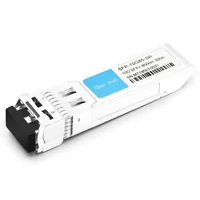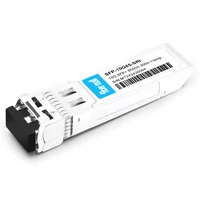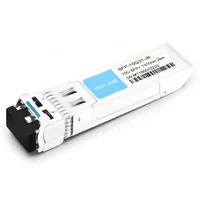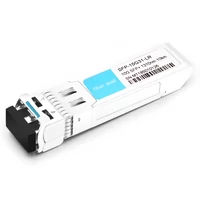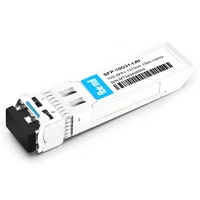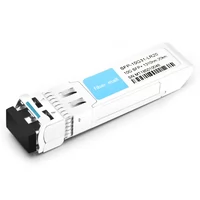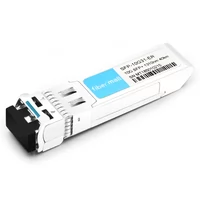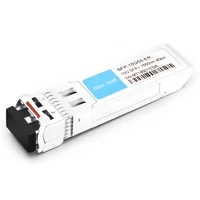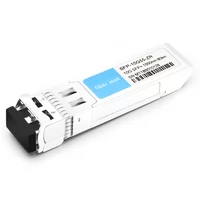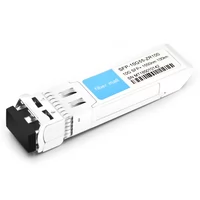SFP+ (Improved Small Form-Factor Pluggable) is a small, heat-dissipating transceiver that can be used for telecommunications and data communications. It is considered to be an improved version of the SFP module standard; thus, it supports speeds up to 16 Gbit/s. The present guide will embrace basic things about SFP Plus modules, such as their design specifications, operational advantages, and applications. This will give readers a wider understanding, thereby enabling them to make educated choices on where and how to use these devices in different networking environments in general terms based on this knowledge alone.
Table of Contents
ToggleWhat Is an SFP Module?
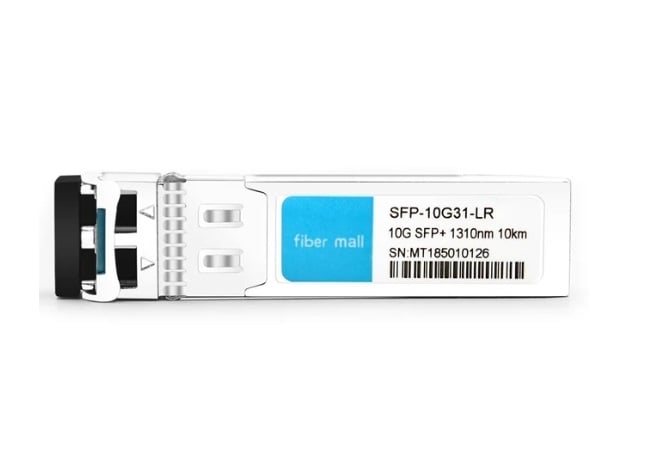
Understanding the SFP Module
A small form-factor pluggable (SFP) module is a network interface device that adheres to a standard, linking network hardware devices such as switches, routers, and network interface cards with fiber optic or copper networking cables. Created specifically for optical media, these modules can accommodate data rates from 100 Mbps to 4 Gbps. One of the key features of SFPs is their hot-pluggability, which means they can be inserted or removed without interrupting network operations. SFP modules find use in Ethernet networks, Fibre Channel, and SONET/SDH networks, among others, thus providing flexibility and great compatibility among various system configurations.
Types of SFP Modules: 10G vs. 1G
In distinguishing between the 10G and 1G SFP modules, there is one main thing that you should know, which is the speed of data transmission. This 1G SFP module, also called as SFP, can work on Ethernet networks and Fibre Channels because it supports up to 1 Gbps. It is part of a gigabit small form-factor pluggable transceiver kit. It has high adaptability and can be used with older systems, making them backward compatible and thus extending the usefulness of pre-existing network infrastructures.
On the other hand, a 10G SFP+ module works with data rates of up to 10 Gbps. With this improvement in performance, it becomes ideal for use in more demanding applications such as high-speed data centers and advanced telecommunications systems among others. What makes these devices even better than before is their low latency together with high throughput capability, which leads to better overall performance, especially when working in environments where fast processing speeds are required while minimizing signal interference.
There are some similarities between these two modules, including support for both single mode as well as multi-mode fiber optics cables (SMF/MMF) and hot pluggability features, but whether to use either one largely depends on bandwidth needs or future scalability plans for any given network setup.
Key Specifications of SFP Modules
Various crucial factors determine the operation and applications of SFP modules. These specifications are as follows:
- Data Rate: The maximum speed of transmission is indicated here; 1 Gbps for typical SFP, while 10 Gbps for SFP+.
- Wavelength: Expressed in nanometers (nm), wavelength shows the point at which modules work through optics. In most cases, multimode fiber use 850 nm while single-mode fiber use 1310 nm or 1550 nm.
- Distance: The furthest distance that a module can cover during transmission; multi-mode fibers cover a few hundred meters, while single-mode fibers can go up to tens of kilometers.
- Fiber Type: It determines whether the module works with single-mode or multi-mode optical fibers correctly; long-haul transmissions apply single modes, while short distances favor multi-modes.
- Connector Type: This refers to the physical connector interface used by a module. LC, SC, RJ45, and MPO are common ones.
- Operating Temperature: It is the range of temperature under which the module can operate without failure, i.e., commercial (0°C to 70°C) or industrial (-40°C to 85°C).
- Power Budget: Total power difference between transmitted signal and minimum received signal necessary for proper operation expressed in dB typically.
- Compliance Standards: Organizations’ certifications or standards, such as IEEE for Ethernet or ANSI for Fibre Channel, are followed so that different systems can interoperate reliably with their environments.
These conditions will enable you to choose an appropriate SFP module depending on your network needs, hence giving equal weightage on performance, compatibility, and scalability considerations.
How Does the Ubiquiti U-Fiber 2 Pack Compare with Other Modules?
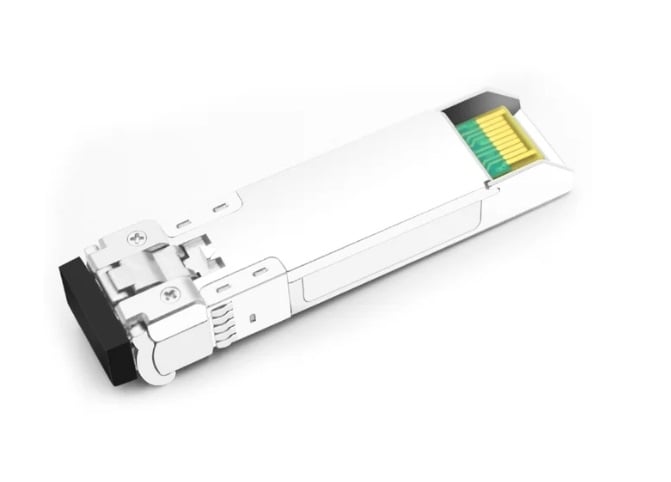
Features of Ubiquiti U-Fiber
Ubiquiti U-Fiber modules are designed to be highly performant and flexible in terms of integration with different networking environments. Here are some of the distinctive features that separate them from other brands:
- Fast and efficient: The transmission speeds supported by Ubiquiti U-Fiber modules range between 1Gbps to 10Gbps, thus ensuring strong performance that can cater to high bandwidth applications.
- Compatibility: They work well with various types of cables, such as single mode fibers (SMF) or multimode fiber(MMF), giving users more options when deploying them over longer or shorter distances for communication purposes.
- Easy installation: ubiquity has always been known to create easy installation products. U-fiber is no exception since they have made it hot-swappable, making this process easier and less hectic for any user who might need these services done quickly without technical skills.
- Long distance abilities- some U-fibers can cover up to 20km away from each other, so it is ideal for use even across metropolitan areas where there could be many buildings requiring network connection points.
- Energy saving: these devices were crafted with power efficiency in mind, thus cutting down on operational costs while still maintaining reliability and performance levels expected by clients.
- Strong structures: This product line boasts enhanced ruggedness against weather conditions thanks mainly to its ability to work within wide temperature ranges found commonly within commercial sites down through industrial establishments, too, if need be.
- Affordability: ubiquity offers cost-effective solutions without compromising quality, making their u-fibers very attractive, especially among growing networks that may not have huge budgets allocated towards acquiring such equipment.
Overall, these characteristics make the ubiquiti fiber modules competitive among other sfp module brands because they provide good service delivery levels through high-speed links combined with ease of use during installation procedures, all at affordable prices.
Advantages of Using the 2 Pack
There are a number of benefits that come with using the 2-pack of Ubiquiti U-Fiber modules.
- Duplication: It can ensure network reliability and ensure continuity in operation. If a module fails, another one can take over immediately reducing downtime.
- Saving on costs: Normally, buying these modules as a pack of two is usually cheaper than purchasing them individually. This is good for organizations with limited budgets that want to get the most out of their investments.
- Scalability: In case a network proliferates, it may be necessary to add more units quickly without having to wait for supply chain delays. Such features are important especially when dealing with networks that constantly change.
These advantages show why it makes sense from practicality and economics standpoints to go for 2 Pack of Ubiquiti U-Fiber modules. They cater for the needs of reliable and flexible network infrastructure.
Ubiquiti U-Fiber vs. Cisco Modules
When assessing Ubiquiti U-Fiber modules against Cisco modules, there are some important points to consider: Performance, compatibility and cost.
- Performance: Both Ubiquiti U-Fiber and Cisco modules provide high-performance fiber optic connectivity. Nevertheless, Cisco modules often come with more advanced functions, like extended temperature range capability or enhanced security options for larger enterprise networks. While designed to deliver robust performance, they may lack certain specialized features available in Cisco products.
- Compatibility: When interoperating with other devices or systems on a network architecture, it’s usually desirable that any given device should be able to work seamlessly well with others within such an environment without compromising its efficiency, as this will guarantee the best performance levels at all times. This being said – ubiquity has wide-ranged compatibility, which can efficiently function across different brands and models of networking equipment, hence making them ideal even for mixed-vendor environments.
- Cost: The price tag is the most obvious difference between these two alternatives. Inexpensive yet top-quality performing devices are what you get when using ubiquiti u-fiber modules, while expensive but feature-rich gadgets combined with extensive support services justify their higher pricing, especially in mission-critical applications or complex network setups where Cisco would be used.
In simple words, whether you choose Ubiquiti U-Fiber or Cisco Modules mainly depends on what your network requires. If you are looking for broad compatibility and cost-effectiveness then go ahead with Ubiquity however, if advanced functionality and seamless integration within Cisco environment is needed, then opt for Ciscos.
What Are the Different SFP Module Types?
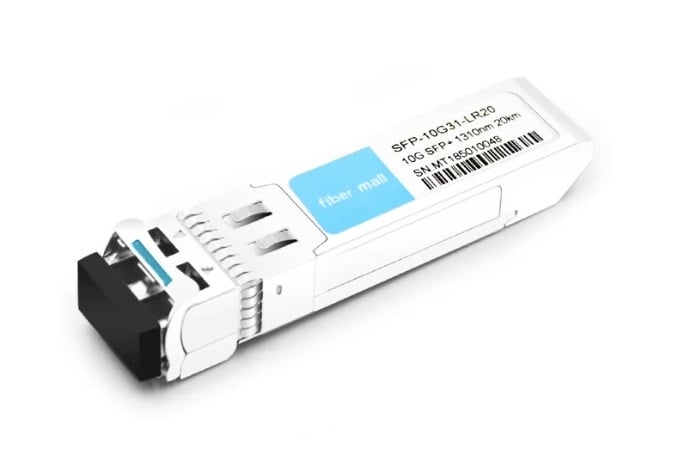
10G SFP Modules
10 Gigabit SFP (Small Form-factor Pluggable) modules are transceivers that support 10GBE, providing high data transfer rates. These are needed in any modern network infrastructure where efficient and reliable data transmission is required. The main types of the 10G SFP module are as follows:
- 10GBASE-SR: This type has been designed specifically for short-range multi-mode fiber optic cable connections covering a distance of about 300 meters. Using a compatible 10Gbe SFP will give you best results. Normally, these modules are used in data centers and LAN applications.
- 10GBASE-LR: For longer distances, this module works over single-mode fiber optic cables with the capability to transmit up to 10 kilometers of data traffic; hence, it is suitable for campus or enterprise backbone networks.
- 10GBASE-ER: These transceivers are used when there needs to be extended range connectivity, i.e., they enable you to send signals through them over one fibre pair at 1550nm wavelength, which allows you to reach up to 40km using SMF –ITU-T standard G.652).
Each type of the 10G SFP module serves different network requirements; therefore, distance limits are important that one chooses appropriate modules based on operational needs within their networks.
LC Duplex vs. Single Mode
It is important to recognize the unique features and functions of LC duplex connectors against single-mode fibers. The LC duplex connector is small in size, which makes it suitable for use in multimode fiber (MMF) cabling systems with high-density connections. These types of connectors are popularly used in data centers as well as enterprise networks where space-saving and quick links over limited distances are needed most. Such needs can be met effectively by the 10GBASE-SR module.
On the contrary, single-mode fibers (SMF) are meant for long-distance transmissions that have a very low loss of signal. Compared to multimode fibers, they have a smaller core diameter, which enables them to send information for longer distances without much attenuation taking place. Usually, these kinds of cables are applied when there is a need for fast data transfer across large areas such as campuses, metropolitan areas, or WANs.
To wrap it up, LC duplex connectors work best at higher densities within shorter ranges while single mode fibers should be used for longer distance communications having minimal losses. The decision between these two will always depend on what is required by the network in terms of service delivery and operational demands.
Multimode Fiber Systems
Multimode fiber systems exploit fibers with larger core diameters, normally 50 or 62.5 microns, to enable the propagation of multiple modes (paths) of light. This allows them to work with bidi modules that transmit data efficiently. Therefore, multimode fiber supports high data rates and bandwidths over smaller distances. For example, because it spreads out the light pulse as it goes on a trip through it, modal dispersion limits multimode fibers to 550 meters for 10 Gigabit Ethernet.
The reason behind their popularity in data centers, local area networks (LANs), storage area networks (SANs), etc., is that they are inexpensive and easy to install. Furthermore, these types of cables often get matched up with vertical-cavity surface-emitting lasers (VCSELs). These lasers operate at either 850 nm or 1300 nm wavelengths which provides high-speed connections within buildings.
There exist several kinds of multimode fibers like OM1, OM2, OM3, and OM4, each designed for different performance levels and distance capabilities. It all comes down to what bandwidth you need at what distance when choosing between them – but just remember: compared to OM1 & OM2 where speeds decrease rapidly as lengths increase beyond certain points, both OM3 & OM4 allow faster speeds over longer distances.
To sum up my argument, I would say this much – if you’re working in close quarters under controlled conditions, then go ahead with using multi-mode systems because not only are they cost-effective, but they also offer great performance ratios! However, there’s no point in setting up an optic network without considering some key factors, such as available budget or end-user requirements based on location-specific needs.
How to Achieve Compatibility with Your Network?
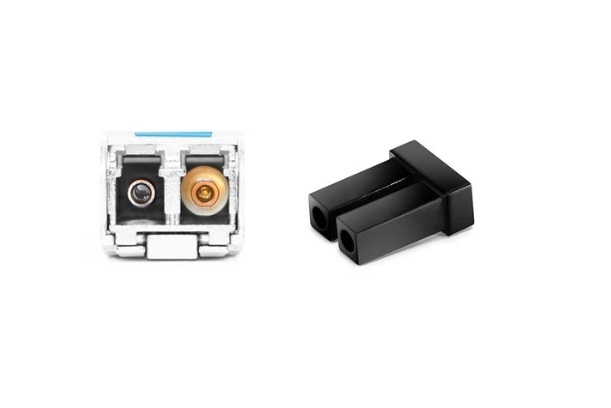
Compatibility with Cisco and Other Brands
To make sure that the network is compatible with Cisco and other brands, there are many things that must be taken into consideration. One of them is to know what networking standards are supported by your current infrastructure in the first place. This company complies with a variety of industry-wide rules, usually thereby making their devices able to work together with other well-known manufacturers such as Juniper, HP, or Arista, among others. When integrating multimode fiber systems, it would be better if one looked at transceiver modules; these should use Cisco SFP and SFP+ modules, which are widely used but can also operate on similar ones made by different companies. Moreover, network protocols matter – ensure that you have equipment supporting standard protocols like Ethernet, OSPF or BGP.
For smooth interoperability, software versions and configurations need to be consistent throughout. It may be helpful to employ network management tools, including DNA Center from Cisco, which enables automated configuration and monitoring across multi-vendor environments. Another important resource is vendor support, along with documentation where necessary; most top-level vendors will provide detailed guides as well as compatibility matrices for integration purposes. Following these guidelines will enable you to achieve maximum compatibility, thus increasing performance reliability levels within your network setup.
Ensuring 850nm Wavelength Support
To support multimode fiber systems, particularly those within short-distance networks such as data centers, it is important to support 850nm wavelength. This wavelength has low attenuation and high bandwidth; this makes it possible for a link up to 550 meters with OM4 fiber. Confirm that your transceivers and cables are capable of supporting 850 nm wavelength for compatibility. Such wavelengths are best optimized by widely used transceivers like Cisco’s SFP-10G-SR modules which provide reliable performance across compatible infrastructures.
Secondly, use high-quality multimode fiber cables that can efficiently transmit signals at the 850nm wavelength like OM3 or OM4. Additionally, network testing and monitoring tools should be used regularly so as to validate performance and detect any potential issues such as attenuation or signal loss. Your network’s reliability on 850 nm wavelength can also be improved by consistent firmware updates and following manufacturers’ guidelines which elongate its life span too. These factors will ensure the best possible performance and compatibility in your fiber optic network setup.
Challenges and Solutions in Achieving Compatibility
Achieving compatibility in a network infrastructure has several challenges and each one needs its own solution:
- Interoperability Issues: This is one of the most common problems where hardware or software components from different manufacturers fail to work seamlessly together. In such cases, it is important to ensure compliance with industry standards like those set by IEEE or ITU. Additionally, thorough testing under controlled conditions can help detect and fix compatibility problems before deployment.
- Firmware and Software Updates: Outdated firmware or software can compromise compatibility, resulting in poor performance or complete failure of some parts. Compatibility should be maintained by regularly updating firmware and software. Also, all devices can be made current through automated processes managed centrally thereby reducing chances of human error.
- Vendor-Specific Implementations: Sometimes, vendors implement standards differently, which might cause compatibility issues. To minimize this risk, it is advisable to select equipment from suppliers that strictly follow recognized norms. Multi-vendor interoperability labs should also be used where necessary, in addition to certifications, to confirm whether different manufacturers’ devices will work together without any problems.
When these challenges are dealt with using proactive solutions, network administrators shall achieve strong networks that are both reliable and meet performance requirements. Modules ought to be chosen based on form factors as well as module supports, among other considerations.
What Distance and Speed Can Be Achieved with SFP Modules?
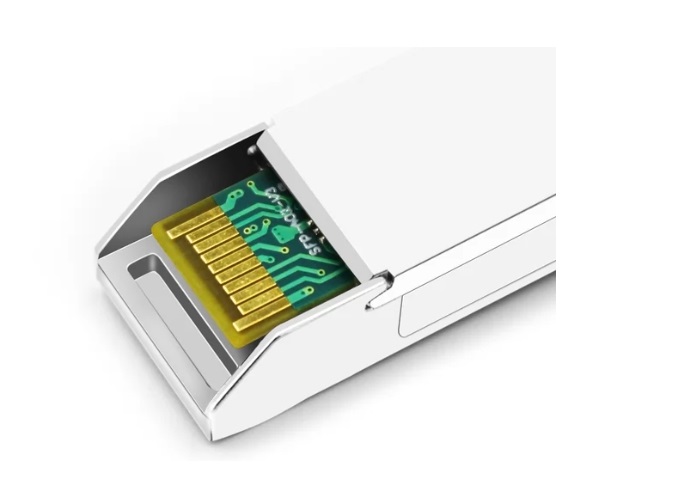
SFP Modules for 300m Distance
To cover 300 meters, the most appropriate SFP module is SFP-10G-SR, which uses multimode fiber (MMF). It can support data rates up to 10 Gbps and has been made for working on OM3 fiber at 850 nm so it can reach a distance of up to 300 meters. The use of laser-optimized OM3 or OM4 fibers could improve performance and guarantee stable connection throughout this range. Quality and characteristics of optic cables must be taken into account too; moreover, correct installation procedures should be followed if maximum efficiency is expected from these SFP modules.
Speeds Up to 10Gbps: What You Need to Know
The way to achieve speeds of up to 10 Gbps is by using high-quality optical components, the correct networking hardware and fiber optic cabling. These capabilities are made possible with SFP+ modules made for high-speed data transfer. The SFP-10G-SR module is commonly used with multimode fibers for short-range connections not more than 300 meters. If there is a need to cover longer distances, solutions such as SFP-10G-LR and SFP-10G-ER should be employed, which can allow transmissions over single-mode fibers up to 10 km and 40 km, respectively.
It is important that you do it right when preparing your infrastructure for supporting 10 Gbps speeds; this means choosing appropriate SFP modules as well as employing laser-optimized fibers like OM3 or OM4 in case of multimode applications. Also, network devices such as routers and switches should have the capacity to handle these data rates, which are higher than normal, so they need powerful machines, too. In order not to compromise on quality, one needs to follow laid down industry standards while installing systems, thus achieving reliable performance levels where necessary, especially at high-speed networks.
Using 10GBASE-SR for Optimal Performance
To achieve the highest performance of 10GBASE-SR, there are some important points to be taken into account. First of all, it is necessary to use good quality multimode fiber optic cables such as OM3 or OM4, which are laser-optimized for a short-range 10GBASE-SR application that supports up to 300 meters of connectivity. Alignment accuracy and cleanliness in your terminations and connectors of fiber optics matter so much since they reduce loss in data transmission.
Secondly, it is necessary to choose reliable SFP+ modules like SFP-10G-SR, which have been designed specifically for handling 10 Gbps over multi-mode fibers, with many being MSA compliant. Make sure you buy these parts from reputable manufacturers to avoid any compatibility or performance problems.
Additionally, strict compliance with installation best practices, as well as industry standards, will guarantee optimum performance. This involves proper cable management so as not to bend them too much, hence introducing stresses, regular inspection together with cleaning of connectors, plus observing recommended environmental conditions in order to prevent signal degradation. Robustness and efficiency in 10GBASE-SR network performance can be achieved by considering the above elements. Also, ensure the right form factor for compatibility and ease of installation.
Is the Operating Temperature Important for SFP Modules?
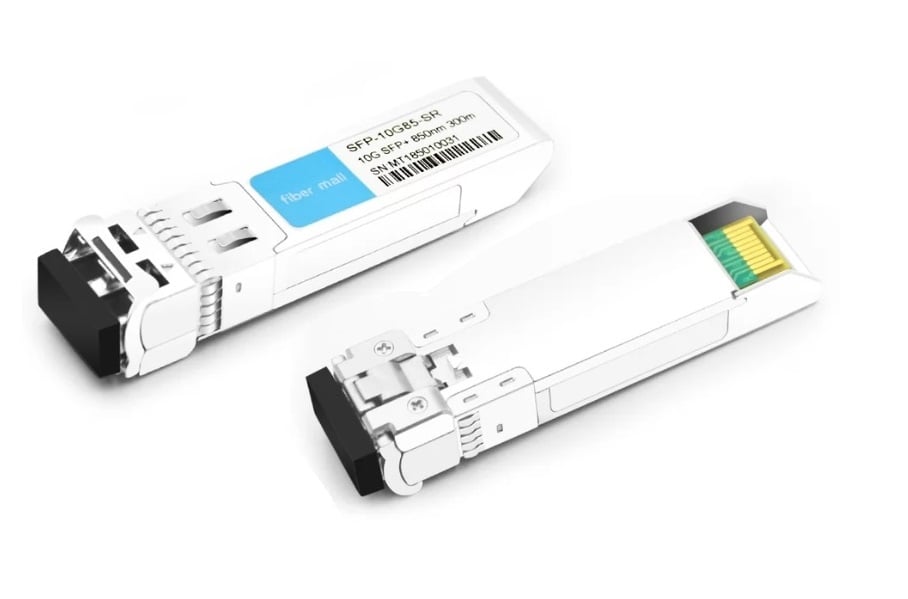
Understanding Operating Temperature Ranges
Both the performance and durability of the SFP modules depend on their operating temperature range. Generally, these modules are divided into two major groups with respect to temperature range; commercial temperature range (0°C to 70°C) and industrial temperature range (-40°C to 85°C). The commercial temperature range is meant for average indoor conditions like those found in office spaces or data centers where there are minimal fluctuations in heat levels.
On the other hand, the industrial temperature range caters to places with more severe conditions, such as outdoor installations and industrial settings where temperatures can change greatly. It is important to choose an appropriate SFP module based on the environment in which it will be used. Using modules beyond their specified temperatures may subject components to stress, thereby causing signal integrity problems and data errors and reducing their lifespan. Each module should support specific environmental conditions under which you want it deployed. Thus understanding these temperature limits for your SFPs is essential if you want to keep network reliability while at the same time achieving optimal performance.
Impact of Temperature on SFP Performance
The performance and reliability of SFP modules depend on temperature. Should the ambient deviate from the module’s operating range indicated by a manufacturer, thermal stress that interferes with laser diodes and other internal components may occur. Signal attenuation can increase while data errors susceptibility can grow when it gets hot. This is besides making such modules fail before time. Conversely, extreme coldness leads to slower speeds of transmission and lowers operational efficiency.
In order to minimize these consequences, choose SFP modules according to their temperature ratings as against where they will be used most frequently. Keeping an eye on environmental conditions together with those inside the modules helps ensure that they are always safe; hence, this maintains peak performance levels while extending service life for any given device. Failure to manage cooling properly along with airflow within data centers or any other facility might expose networks to thermal shocks, which eventually compromise reliability across various network points.
Best Practices for Maintaining Optimal Conditions
- Environmental Monitoring: Environmental sensors can be used to supervise continuous temperature and humidity in data centers or deployment areas. Thermal sensors coupled with intelligent PDUs can give warnings whenever environmental conditions are almost reaching dangerous levels, enabling action earlier enough.
- Sufficient Cooling: Keep machines at a constant temperature by employing efficient cooling systems, e.g., cold/hot aisle containment. Air conditioners and ventilation equipment should be inspected frequently to ensure that they’re operating optimally. Also, considering liquid cooling solutions would help dissipate heat more rapidly for high-density setups.
- Frequent Maintenance: Regularly check SFP modules and cooling systems. Dust and other particles should be removed from filters while ensuring proper airflow, which prevents them from overheating. Network devices need firmware updates on a regular basis, too, so that they can perform better and deal with any probable thermal challenges.
- Correct Installation: Ensure that you have put your sfp module into the right slots and that connectors are firmly attached. Avoid overcrowding racks or switch cabinets so as to allow for more space around the modules through which air flows freely. Heat accumulation is greatly reduced when port management is properly done; it’s also good practice to install equipment according to the manufacturer’s recommendations because this significantly reduces thermal risks.
Following these guidelines will enable network administrators to operate within optimal conditions, thereby improving the performance and reliability of their infrastructure in general.
Reference Sources
Frequently Asked Questions (FAQs)
Q: What is an SFP+ module?
A: An SFP+ module refers to a small form-factor pluggable transceiver that supports high-speed ethernet and fiber optic connection commonly used in data centers and network environments. It is an improved version of the standard SFP transceiver module designed for 10 Gbps data rates.
Q: What kinds of cables work with SFP+ modules?
A: Different types of cables can be used with SFP+ modules such as fiber optic cables like MMF (Multi-Mode Fiber) and SMF (Single-Mode Fiber) as well as DAC (Direct Attach Copper) cables. In most cases, specific optical cable types, such as OM3 and OM4, are utilized for short-range connectivity.
Q: Can you use single-mode and multi-mode fiber with SFP+ modules?
A: Yes, it is possible to design SFP+ modules that support both single-mode fiber (SMF) and multi-mode fiber (MMF). When the performance metrics meet the specified standards, users should be notified accordingly. The difference comes from the kind of SFP+ transceiver module you buy; for instance, 10GBASE-LR is used in single mode while 10GBASE-SR is for multi-mode fiber applications.
Q: What are some typical applications of an sfp+ module within a network setting?
A: Data centers, enterprise networks, service provider transport applications and Ethernet environments typically employ or utilize sfp plus modules. Often they include RJ45 ports so that they may have additional compatibility or flexibility options available if needed. They allow servers, switches, or other network devices to connect at high speeds where this may not always be possible, especially in rack-mounted gear.
Q: How do I know if my network device will work with an SFP Plus module?
A: Whether or not something works together depends on the specifications of one device against what another device supports when plugged into it directly. Always refer back to what the manufacturer states in their documentation for your network device; this can include companies like Arista, Juniper, or Ubiquiti, etc., so terms like “10GBASE-SR SFP” or “10GBASE-LR SFP” should be mentioned somewhere as well as whether or not the transceiver module kit is compatible with your hardware.
Q: What is the difference between active optical and passive optical SFP+ modules?
A: Active optical SFP+ modules are equipped with electrical parts to amplify signal transmission, frequently across longer distances or at higher rates of speed. Passive optical modules lack these parts and depend entirely on the fidelity of the light signal. Both types find application in fiber optic networks, depending on the connectivity requirements.
Q: How does SFP+ module power consumption affect network design?
A: Power usage is an important consideration when designing networks, especially those deployed densely within data centers. Reduced power consumption modules should be used as they contribute to lower overall energy bills and cooling needs. Typical SFP+ modules have been designed with low power budget but keep high performance at the same time.
Q: Are SFP+ modules hot-swappable?
A: Yes, SFP+ modules can be hot-swapped. This means that you can insert or remove them from a network device without powering down, making it possible to perform flexible maintenance/upgrade operations.
Q: Where can I buy SFP+ modules?
A: You can purchase SFP+ modules from various suppliers, including fibermall in the United Kingdom or other specialized vendors. However, always ensure that you buy them from reputable sources so that they work well with your network hardware.
Q: How will I get notified about new releases of SFP+ Modules?
A: Many manufacturers offer notification services that keep customers informed about new products being released into the market. For instance, you could sign up on the fs.com website and get instant updates whenever there are new transceiver module arrivals, such as Ubiquiti U-Fiber or Juniper compatible, among others.
Related Products:
-
 SFP-10G85-SR 10G SFP+ SR 850nm 300m LC MMF DDM Transceiver Module
$12.00
SFP-10G85-SR 10G SFP+ SR 850nm 300m LC MMF DDM Transceiver Module
$12.00
-
 SFP-10G85-SRI 10G SFP+ SR 850nm 300m LC MMF DDM Industrial High Temperature Transceiver Module
$13.00
SFP-10G85-SRI 10G SFP+ SR 850nm 300m LC MMF DDM Industrial High Temperature Transceiver Module
$13.00
-
 SFP-10G31-IR 10G SFP+ IR 1310nm 2km LC SMF DDM Transceiver Module
$15.00
SFP-10G31-IR 10G SFP+ IR 1310nm 2km LC SMF DDM Transceiver Module
$15.00
-
 SFP-10G31-LR 10G SFP+ LR 1310nm 10km LC SMF DDM Transceiver Module
$18.00
SFP-10G31-LR 10G SFP+ LR 1310nm 10km LC SMF DDM Transceiver Module
$18.00
-
 SFP-10G31-LRI 10G SFP+ LR 1310nm 10km LC SMF DDM Industrial High Temperature Transceiver Module
$20.00
SFP-10G31-LRI 10G SFP+ LR 1310nm 10km LC SMF DDM Industrial High Temperature Transceiver Module
$20.00
-
 SFP-10G31-LR20 10G SFP+ LR 1310nm 20km LC SMF DDM Transceiver Module
$22.00
SFP-10G31-LR20 10G SFP+ LR 1310nm 20km LC SMF DDM Transceiver Module
$22.00
-
 SFP-10G31-ER 10G SFP+ ER 1310nm 40km LC SMF DDM Transceiver Module
$25.00
SFP-10G31-ER 10G SFP+ ER 1310nm 40km LC SMF DDM Transceiver Module
$25.00
-
 SFP-10G55-ER 10G SFP+ ER 1550nm 40km LC SMF DDM Transceiver Module
$80.00
SFP-10G55-ER 10G SFP+ ER 1550nm 40km LC SMF DDM Transceiver Module
$80.00
-
 SFP-10G55-ZR 10G SFP+ ZR 1550nm 80km LC SMF DDM Transceiver Module
$150.00
SFP-10G55-ZR 10G SFP+ ZR 1550nm 80km LC SMF DDM Transceiver Module
$150.00
-
 SFP-10G55-ZR100 10G SFP+ ZR 1550nm 100km LC SMF DDM Transceiver Module
$280.00
SFP-10G55-ZR100 10G SFP+ ZR 1550nm 100km LC SMF DDM Transceiver Module
$280.00

